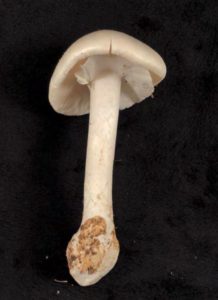First Deadly Mushroom Ever Found in Metro Denver Appears in Aurora
Colorado Mycologists Issue Warning about Deadly “Destroying Angel” Mushroom
By Jason Salzman
You can find scores of mushrooms in Denver’s parks and lawns, some poisonous and some edible, but Denver was thought to be free of mushrooms classified as deadly. That changed over the weekend with the discovery of the “Destroying Angel” in a peaceful Aurora lawn.
The mushroom, known by mycologists as Amanita bisporigera, is rare in Colorado, having been found just eight times here, all south of Castle Rock to El Paso County growing under Gambel Oak trees, according to records kept by the Denver Botanic Gardens Sam Mitchel Herbarium of Fungi.

“The Destroying Angel is pure white, from cap to gill tocup at the base. It’s smooth, without warts on the cap, and is slightly bulbous at the base of the stem, which has a ring-like membrane near the top. The important feature is the cup-like sack buried in the ground at the base of the stem.”
“The Destroying Angel might land in your yard next, especially if you have an Oak tree,” said Linnea Gillman, a past president of the Colorado Mycological Society, who holds a master’s degree in mycology from Virginia Tech University. “We don’t want to turn people into mycophobes, because there’s already plenty of fear of mushrooms out there, and deadly mushrooms are still rare in Denver. But everyone should know that the Destroying Angel has now been found in the Denver area.”
A close relative of the mushroom found in Aurora, called the western Destroying Angel, is common in some states, like California, leading forest rangers to post warning signs about the mushroom’s toxicity along some hiking trails. But such precautions have been deemed unnecessary in Colorado, where mushrooms found in the state have yet to cause the death of anyone.

The specimen was found by Aurora resident Lazarus Bell, a member of the Colorado Mycological Society, who was hunting for mushrooms near his home when he spotted the fungus growing out of the grass in a yard with a white oak. He asked the home owner for permission to pick the
shroom, which he identified as a deadly Amanita. The identification was confirmed by Linnea Gillman, who examined the spores and tissue under the microscope and confirmed it with other experts at the Denver Botanical Gardens’ Herbarium of Fungi. Now the mushroom will be carefully preserved at the herbarium and further studied by experts there and around the country.
The news of the unusual find spread quickly in the Denver media, with the mushroom (as well as Bell, Gillman, and CMS guru Vera Evenson) making appearances on all of Denver’s TV stations and other news outlets.
The Destroying Angel’s deadly poison (amatoxins) attack the liver, with damage and symptoms often not appearing until many hours after ingestion of the mushroom, making medical treatment difficult but not futile. It’s equally a danger to humans and pets.

For comprehensive information about the mushrooms of metro Denver, you can visit www.urbanmushrooms.com. The site has information about mushrooms in yards, parks, and other urban habitats. Basic information about mushroom identification is included, as are recipes for cooking up edible varieties (which should only be consumed after expert identification).
